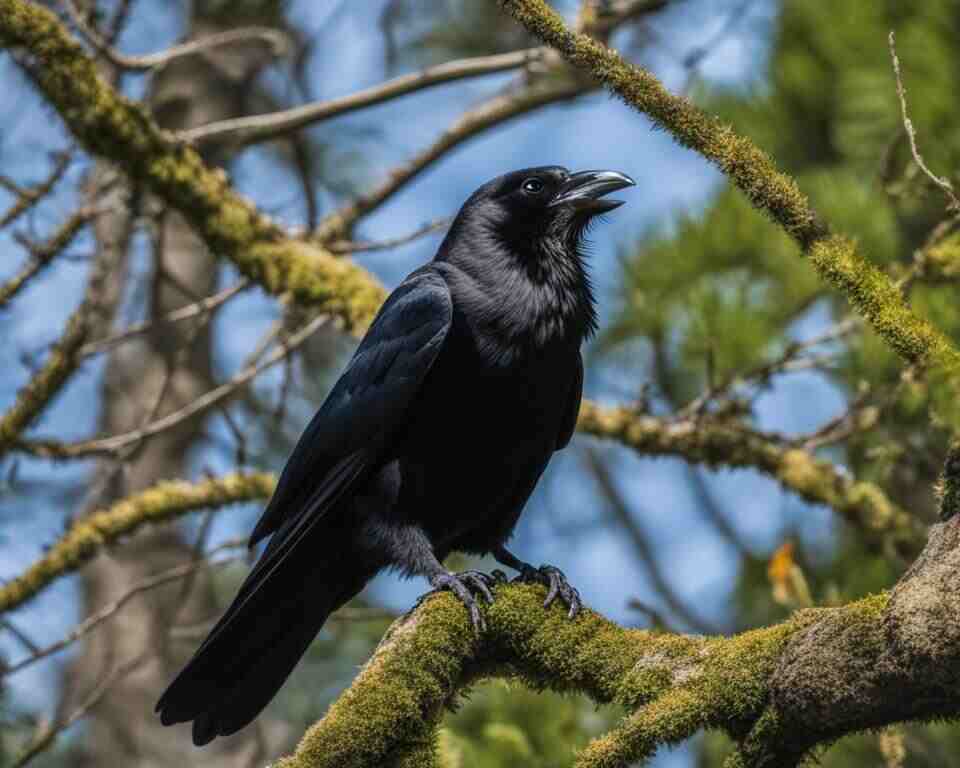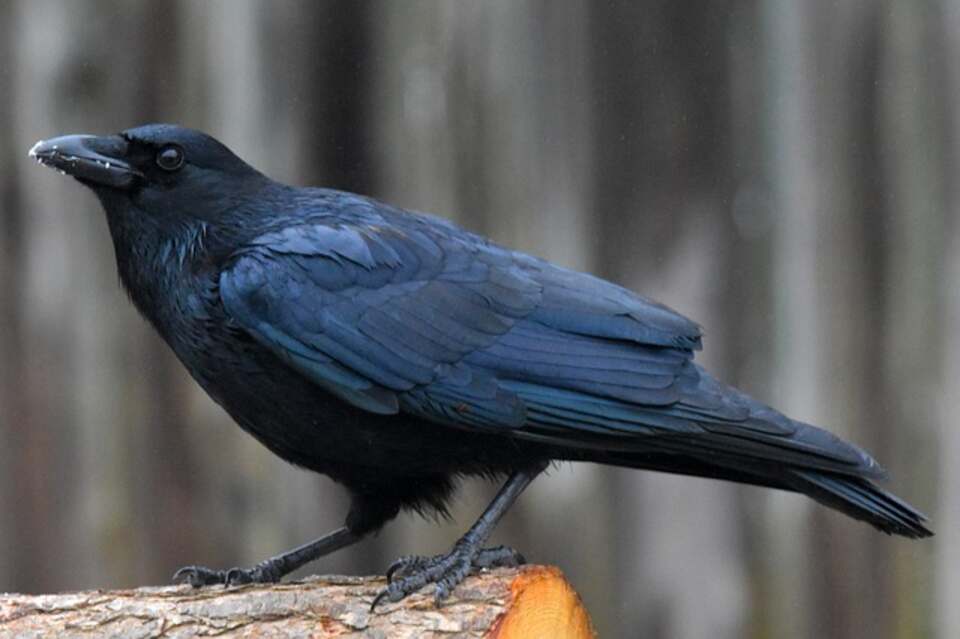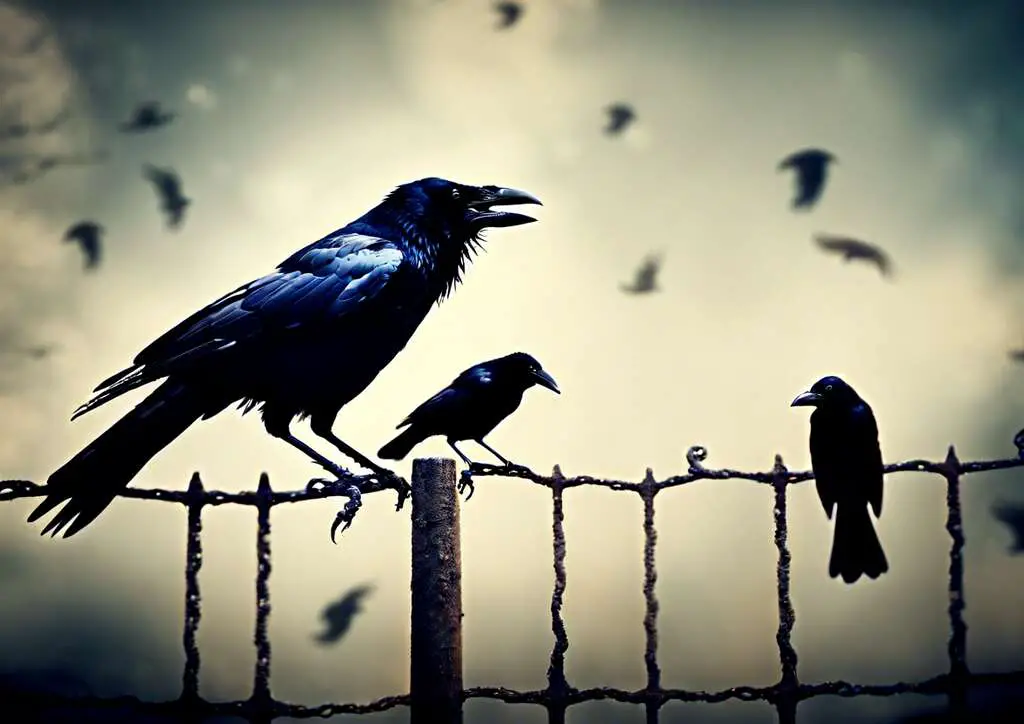Have you ever wondered what’s on the menu for crows? Join us as we take a closer look at the dietary habits of these fascinating birds. In this exploration, we’ll tackle a common question: Do crows have a penchant for preying on other birds? Let’s unravel the mysteries of their diet together.
Table of Contents
Key Takeaways:
- Crows are known to prey on other birds, contributing to their diverse diet.
- Understanding crow feeding habits provides insight into their role in the ecosystem.
- Their predatory behavior underscores the complexity of avian interactions.
- Exploring crow behavior offers fascinating insights into wildlife dynamics.

Do Crows Eat Other Birds?
Crows, highly intelligent and adaptable birds, are known for their varied diet, which includes both plant matter and other animals. While crows are omnivorous and eat a wide range of food items, including seeds, fruits, insects, and small mammals, they do occasionally prey on other birds as well. It is a common misconception that crows only scavenge on dead animals or eat trash; they are also opportunistic hunters.
When it comes to their diet of other birds, crows are known to target nestlings and eggs of smaller bird species. They are particularly drawn to the vulnerable young in nests as they are easy prey. Crows are extremely skilled at locating bird nests, often using their sharp eyesight and keen intelligence to spot potential targets from a distance. Once they identify a nest, they may raid it for eggs or even attack the nestlings.
Crows employ various strategies to capture other birds. They may use distraction techniques to lure adult birds away from their nests, creating an opportunity to steal eggs or young ones. Additionally, crows have been observed working together in groups to overwhelm and drive away adult birds protecting their nests. Their collaborative hunting behavior makes them efficient predators when targeting other birds.
The impact of crow predation on bird populations can be significant, especially for species that are already facing challenges such as habitat loss or climate change. The loss of eggs or nestlings to crows can affect the reproductive success of various bird species, potentially leading to declines in their numbers over time. Conservation efforts often involve understanding and managing these predator-prey dynamics to ensure the survival of vulnerable bird populations.
While crows do eat a diverse range of foods, including plants, insects, and small mammals, they are also known to prey on other birds, particularly nestlings and eggs. Their predatory behavior is a natural part of the ecosystem, but it can have implications for the populations of certain bird species. Understanding the dietary habits and hunting strategies of crows is essential for promoting coexistence among different bird species in the wild.
Dietary Habits of Crows: Understanding their Prey
Crows, known for their intelligence and adaptability, have a diverse diet that includes a wide range of food sources. When it comes to understanding their prey, crows are opportunistic feeders that consume various items depending on availability and ease of access. Although crows primarily feed on fruits, seeds, and insects, they are also known to prey on smaller animals, including other birds.
In urban and suburban areas, crows have been observed hunting and consuming smaller bird species. This behavior is more common during nesting seasons when crows are in search of food to feed their young. It is essential to note that not all crows exhibit this predatory behavior towards other birds, as food availability plays a significant role in their hunting habits.
While crows may not be specialist bird hunters, they utilize their intelligence and group strategies to capture other birds. Crows often work together in groups to target nests and young chicks of smaller bird species. Their sharp beaks and agile flight allow them to outmaneuver their prey, making them efficient hunters in certain situations.
The impact of crow predation on bird populations can vary depending on factors such as habitat and ecosystem resilience. In some cases, the presence of crows preying on other bird species can lead to a decline in their numbers, especially if the targeted species are already facing threats such as habitat loss or climate change.
To minimize the impact of crow predation on bird populations, conservation efforts often focus on creating diverse habitats that support a wide range of bird species. By promoting biodiversity and ensuring the availability of food sources for all birds, including crows, it is possible to foster a more balanced ecosystem where predation pressure is distributed more evenly.
While crows do eat other birds as part of their diet, this predatory behavior is influenced by various environmental factors. Understanding the dietary habits of crows and their interactions with other bird species is essential for promoting coexistence and maintaining healthy bird populations in diverse ecosystems. By studying and learning from these interactions, we can better appreciate the intricacies of nature’s web and work towards creating sustainable environments for all wildlife to thrive.

Impact of Crow Predation on Bird Populations
Crows are highly intelligent and opportunistic birds known to feed on a wide variety of items, ranging from insects and fruits to small mammals and even the eggs of other birds. One of the more controversial aspects of crow behavior is their tendency to prey on other bird species. It is well-documented that crows do, in fact, eat other birds, which can have significant implications for bird populations in certain areas.
When crows target other birds as prey, they can impact local ecosystems in various ways. For one, their predation can directly reduce the numbers of certain bird species, especially those that nest in open areas or have relatively exposed nests. This direct pressure can lead to declines in populations of vulnerable bird species, which can have cascading effects on the ecosystem as a whole.
Moreover, the presence of crows as predators can induce stress responses in other bird species, affecting their reproductive success and overall fitness. The constant threat of predation from crows can force other birds to divert energy from breeding efforts to vigilance and defense, ultimately affecting their ability to survive and reproduce successfully.
In addition to the direct effects on bird populations, crow predation can also trigger indirect consequences within the ecosystem. For instance, if certain bird species decline due to crow predation, there may be a surge in the populations of their prey items, leading to imbalances in the food chain. This imbalance can then reverberate through the ecosystem, influencing the abundance and distribution of other species.
To address the impact of crow predation on bird populations, conservationists and researchers have been exploring various strategies. These may include habitat modification to provide better shelter for nesting birds, the implementation of scare tactics to deter crows from specific areas, or the use of exclusion methods to protect vulnerable bird populations from predation.
The impact of crow predation on bird populations is a complex issue that requires a nuanced understanding of ecological dynamics. By studying the interactions between crows and other bird species, researchers can gain insights into how best to mitigate the negative effects of crow predation and promote the coexistence of diverse bird populations in a given ecosystem.
How Crows Hunt and Capture Other Birds
Crows are known for their intelligence and adaptability when it comes to hunting for food. When it comes to capturing other birds, crows have developed various strategies to help them succeed in their pursuit. One common method that crows use is stalking their prey from a hidden vantage point, waiting patiently for the right moment to strike.
Once a crow has identified a potential target, it will move quickly and decisively to catch the bird off guard. Crows are agile fliers and are able to outmaneuver many other bird species, giving them an advantage when hunting. They use their sharp beaks to grasp and injure their prey, making it easier for them to capture and ultimately consume.
In some cases, crows will work together in a group to target larger or more evasive birds. This cooperative hunting behavior, known as mobbing, allows crows to overwhelm their prey through sheer numbers and persistence. By coordinating their efforts, crows can increase their chances of a successful hunt.
It’s important to note that while crows do hunt and eat other birds, this behavior is not the sole focus of their diet. Crows are omnivorous creatures that will consume a wide variety of foods, including insects, small mammals, eggs, carrion, and human food scraps. Their opportunistic nature makes them versatile hunters capable of adapting to different environments and food sources.
Crows are proficient hunters that use a combination of stealth, agility, and cooperation to capture other birds. While this behavior may impact local bird populations, it is just one aspect of the complex relationship between crows and their environment. By understanding how crows hunt and interact with other birds, we can gain a deeper appreciation for the intelligence and resourcefulness of these fascinating creatures.
Coexistence Strategies for Birds in Areas with Crows
The presence of crows in an area can pose challenges for other bird species, but there are strategies that can help promote coexistence among different bird populations. Understanding the behaviors and habits of crows is essential in developing effective coexistence strategies that minimize conflict and competition for resources.
One effective strategy for promoting coexistence is creating a diverse habitat that caters to the needs of various bird species. By providing a range of food sources, nesting sites, and perching options, different birds can find niches within the environment that reduce direct competition with crows. Planting a variety of vegetation that produces seeds, fruits, and insects can attract different bird species and create a more balanced ecosystem.
Another strategy is to implement scare tactics to deter crows from dominating an area. Visual deterrents such as shiny objects, scarecrows, or predator decoys can help in keeping crows at bay and create a safer space for other birds to thrive. Acoustic deterrents like playing recordings of predator calls or distress signals can also be effective in repelling crows and giving other birds a better chance at survival.
Collaborative efforts among bird enthusiasts, conservation groups, and local communities can also play a significant role in promoting coexistence. Monitoring bird populations, identifying areas of concern, and implementing conservation measures can help in maintaining a balanced ecosystem where crows and other birds can coexist harmoniously. Educating the public about the importance of biodiversity and the role of each bird species in the ecosystem can foster a greater appreciation for the diversity of avian life.
Promoting coexistence among birds in areas with crows requires a multifaceted approach that addresses habitat needs, implements deterrent measures, and fosters community involvement. By working together to create a more hospitable environment for all bird species, we can ensure that crows and other birds can share the same space without compromising each other’s survival.

Conclusion
The dietary habits of crows and their potential impact on other bird populations are topics that continue to intrigue researchers and bird enthusiasts alike. The question of whether crows eat other birds has been answered with evidence of occasional predation, although it is not a common occurrence. Understanding the factors that drive crow behavior and prey selection can shed light on how various bird species coexist in shared habitats.
Crows are omnivorous birds with a diverse diet that includes insects, small mammals, carrion, fruits, and human food waste. While they have been observed preying on other birds, such behavior is more opportunistic and influenced by factors like food availability and breeding season. Crows may target eggs, nestlings, or injured birds, but they are not specialized predators of other avian species.
The impact of crow predation on bird populations varies depending on the abundance of prey species, habitat characteristics, and the overall ecosystem dynamics. In some cases, crows can contribute to regulating populations of certain bird species by targeting weaker individuals or controlling pest species. However, excessive predation pressure from crows can pose a threat to vulnerable bird populations, especially in fragmented or urbanized environments.
Crows are intelligent and adaptable hunters that employ a variety of strategies to capture their prey. Their hunting techniques may include stalking, ambushing, or scavenging for vulnerable targets. Crows have also been observed cooperating in groups to improve their hunting success, demonstrating complex social behaviors and communication skills.
For birds coexisting in areas with crows, adopting certain strategies can help minimize the risks of predation. Building nests in concealed locations, using decoy nests, or establishing colonies with collective defense mechanisms are some ways in which birds can protect themselves and their offspring from crow predation. Additionally, maintaining diverse habitats with ample food sources and nesting sites can support a healthy bird community with reduced vulnerability to predation.
The interactions between crows and other bird species highlight the complexity of ecological relationships in natural environments. While crows may occasionally prey on other birds, they play a vital role in ecosystem functioning and contribute to biodiversity. By studying the dietary habits, hunting behaviors, and coexistence strategies of crows, researchers can gain valuable insights into avian ecology and conservation efforts to protect bird populations for future generations to enjoy.



